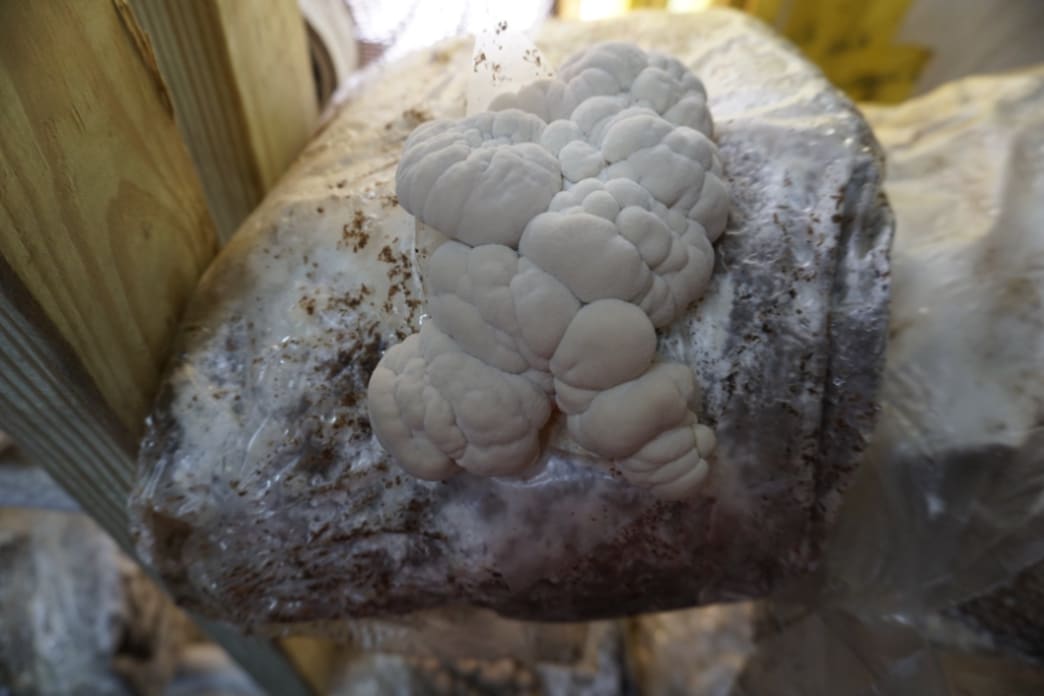The lion’s head mushroom comes with many names, but they all lead to one delicious mushroom that’s as much fun to look at as it is to grow and eat!
The lion’s head mushroom has many names. First and foremost, its scientific name is Hericium erinaceus. It is commonly known as the lion’s mane mushroom, pom pom mushroom, bearded hedgehog mushroom, monkey head mushroom, bearded tooth mushroom, and satyr’s beard.
Many of these descriptive names come from the physical appearance of the mushroom itself. One can look at a fruiting Hericium erinaceus and see the ‘teeth’, the ‘beard’, the ‘mane’, and “the pom pom” shape. There are so many cool things about this mushroom that goes beyond its look, so today we are taking a deeper dive into the world of the lion’s head mushroom.
Growing the lion’s head mushroom at home or commercially
The lion’s head mushroom grows on trees, so it is one of the wood-loving mushrooms. This means that you can grow this mushroom at home on logs, totems, and tree stumps. If you plan on trying it, make sure to use oak, beech, or sugar maple logs.
Using plug spawn or sawdust spawn are great options for inoculating these logs. To inoculate your logs, use a drill to create about 20 holes in the face of the log. The holes should be about 1” deep and spaced 6” apart in the row. Rotate the log 2” to start the next row. Drill all the way around the surface of the log with 2” in between rows and 6” in between holes in the row. The rows can be offset creating a diamond pattern.Hammer your plug spawn into the hole, or if you are using sawdust spawn, fill the drilled-hole with the spawn.
Once you have the holes drilled, Fill them with either plug or sawdust spawn. If using plug spawn, place each dowel on the hole and hammer until it is flush with the surface of the log. If you are using sawdust spawn, fill the hole with the spawn. Make sure you fill the hole completely with sawdust spawn. Sometimes it can look like it is full but there may only be a small amount of sawdust spawn inside. Note: Using a palm inoculator is a good idea if you are doing over 20 logs this way.
Next, wax over the filled holes so the spawn stays moist, has a safe place to grow, and intruders are kept out.
Finally, stack the logs in a shaded area. Conifer works best for the year-long incubation of logs. Logs that are inoculated in April will begin their fruiting period the following June. Be sure to maintain moisture around 45% during the incubation period. It is critical to water the logs every 2-3 weeks if there is no rainfall. To water, either soak for 4-5 hours (although this can be very labor intensive) or place a sprinkler on for 4-8 hours.
Using a lion’s head mushroom growing kit for the fastest harvest
Our lion’s head mushroom growing kits are 10 pounds of colonized substrate and certified organic. They come ready to use and you can have your first flush of fresh mushrooms within two weeks of starting the kit.
To start, simply cut V-shaped holes in the plastic bag that surrounds the kit and mist the kit with water 2-3 times each day. The ideal temperature and humidity for fruiting your lion's head mushroom kit is between 45-70˚F with a relative humidity of 80-85%.
Keep the environmental conditions in this range and you’ll have fresh mushrooms in no time!
Knowing when to harvest your fresh lion’s head mushrooms
The lion’s head mushroom grows little teeth or spines that protrude from the fruited body of the mushroom. These spines develop as the mushroom matures and they are not there when the mushrooms are young. As the mushrooms mature, these spines first protrude outwards and then cascade downward to the body of the mushroom.
When you use one of our lion’s head mushroom growing kits, the fresh lion’s head mushrooms will fruit from the holes you cut into the plastic kit surrounding the kit. Once this happens, you can simply grab the fruited body, twist and pull. This should allow you to easily remove the mushroom from the rest of the kit. We recommend removing the base of the mushroom from where it was pulled from the kit because this part is often tough. The rest of the lion’s head mushroom is delicious and ready to eat!
Lion’s head mushroom extracts are a great way to support health and well being
As you may have noticed above, the scientific name of lion’s head mushroom is Hericium erinaceus. As the name suggests, this mushroom has constituents known as hericenones and erinacines. Let’s begin with a definition of these constituents.
According to RestorativeMedicine.org, “Hericenones A, B, C, D, E, F, G, and H are aromatic compounds isolated from the fruiting bodies of Lion's mane mushroom. Hericenones have shown a strong stimulatory effect on the biosynthesis of nerve growth factor (NGF) in vitro.”
The same source defines erinacines as,“Cyathin diterpenoids that appear to stimulate the synthesis of NGF.
The more you know…

